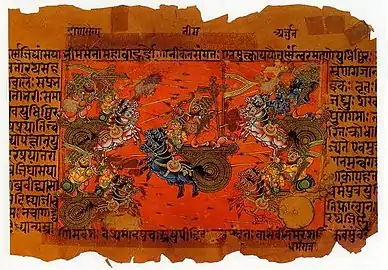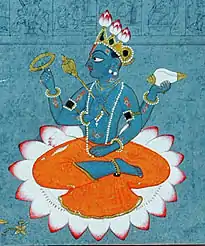Vyasa
Krishna Dvaipāyana, also known as Vyasa (/ˈvjɑːsə/; Sanskrit: व्यासः, romanized: Vyāsa, lit. 'Compiler') and Veda Vyāsa (वेदव्यासः, Veda-vyāsaḥ, "the one who classified the Vedas"), is a rishi (sage). He is best known as the traditional author of the Mahabharata, one of the two most important epics of Hinduism. He is also credited as the traditional compiler of the Vedas, as well as the writer of other important works including the Puranas.
Vyasa | |
|---|---|
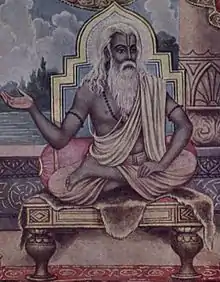 A painting of Vyasa sitting on a throne. | |
| Personal | |
| Born | Krishna Dvaipayana |
| Religion | Hinduism |
| Spouse | Vatikā[lower-alpha 1] |
| Children |
|
| Parents | |
| Notable work(s) | |
| Known for | Compilation of the four Vedas; Mahabharata |
| Religious career | |
Disciples
| |
| Honours | Festival of Guru Purnima, is dedicated to him, and also known as the Vyasa Purnima |
As per the Mahabharata, Vyasa is the son of rishi Parashara and a fisherwoman named Kali (Satyavati), who later marries king Shantanu of Kuru. Throughout the epic, Vyasa appears occasionally helping the Kuru kingdom. His spiritual career includes compiling many texts and spreading the knowledge through his disciples.
The festival of Guru Purnima is dedicated to him. It is also known as Vyasa Purnima, the day believed to be both of his birth and when he divided the Vedas.[3][4] Vyasa is considered one of the seven Chiranjivis (long-lived, or immortals), who are still in existence according to Hindu tradition.
| Part of a series on | |
| Hindu philosophy | |
|---|---|
 | |
| Orthodox | |
|
|
|
| Heterodox | |
|
|
|
Spiritual life and disciples
Vyasa is believed to be an expansion of the God Vishnu, who came in Dvapara Yuga to make all the Vedic knowledge from oral tradition available in written form. According to the Mahabharata, he was the son of Satyavati, daughter of a fisherman chief and the wandering sage Parashara, who is credited with being the author of the first Purana, Vishnu Purana.[5] He was born on an island in the river Yamuna and was named Krishna Dvaipayana because of his dark complexion and birthplace.[6] It is believed that the name "Veda Vyasa" (lit "compiler of the Vedas") is a title rather than an actual name. Dvaipayana was given the title as he mastered the one combined Vedic scripture and divided it into four parts — Rigveda, Samaveda, Yajurveda and Atharvaveda.[7][8]
Vyasa had a son named name Shuka, who was his spiritual successor and heir.[lower-alpha 2] As per Skanda Purana, Vyasa married Vatikā, alias Pinjalā, who was the daughter of a sage named Jābāli. It is described that Vyasa's union with her produced his heir, who repeated everything that he heard, thus receiving the name Shuka (lit. Parrot).[1][2][9] Other texts including the Devi Bhagavata Purana also narrate the birth of Shuka but with drastic differences. Vyasa was desiring an heir, when an apsara (celestial damsel) named Ghritachi flew in front of him in form of a beautiful parrot, causing him sexual arousal. He discharges his semen, which fell on some sticks and a son developed. This time, he was named Shuka because of the role of the celestial parrot.[7] Shuka appears occasionally in the story as a spiritual guide to the young Kuru princes.
Besides his heir, Vyasa had four other disciples — Paila, Jaimini, Vaishampayana and Sumantu.[8] Each one of them was given the responsibility to spread one of the four Vedas. Paila was the made the incharge of Rigveda, Jaimini of the Samaveda, Vaishampayana of the Yajurveda and Sumantu of Atharvaveda.[10]
Vyasa is believed to have lived on the banks of Ganga in modern-day Uttarakhand. The site was also the ritual home of the sage Vashishta, along with the Pandavas, the five brothers of the Mahabharata.[11]
In the Mahabharata
Birth
During her youth, Satyavati was a fisherwoman who used to drive a boat. One day, she helped Parashara to cross the river Yamuna. He was enchanted by her beauty and wanted an heir from her. Initially, Satyavati did not agree, telling that if others would see them, then her purity would be questioned. Parashara created a secret place in bushes of a nearby island and a blanket of thick fog. She conceived and immediately gave birth to a son. Parashara named him Krishna Dvaipayana, referring to his dark complexion and birthplace.[12] Dvaipayana became an adult and promised his mother that he would come to her when needed. Parashara restored Satyavati's virginity, gifted her an enchanting smell and left with his son. Satyavati kept this incident a secret, not telling even King Shantanu whom she was married to later.[7]
Niyoga and birth of Vichitravirya's sons
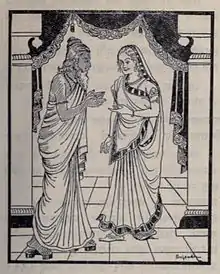
Shantanu and Satyavati had two sons, named Chitrāngada and Vichitravirya. Both of them died early without leaving an heir, but Vichitravirya had two wives — Ambika and Ambalika. A widowed Satyavati initially asked her stepson, Bhishma, to marry both the queens, but he refused, citing his vow of celibacy. Satyavati revealed her secret past and requested him to bring her firstborn to impregnate the widows under a tradition called Niyoga.[13] By this time, Vyasa had compiled the Vedas.
Sage Vyasa was ugly with a dark complexion and matted hair. Hence upon seeing him, Ambika who was rather scared shut her eyes, resulting in their child, Dhritarashtra, being born blind. The other queen, Ambalika, turned pale upon meeting Vyasa, which resulted in their child, Pandu, being born pale. Alarmed, Satyavati requested that Vyasa meet Ambika again and grant her another son. Ambika instead sent her maid to meet Vyasa. The duty-bound maid was calm and composed; she had a healthy child who was later named Vidura.
Connection with the Pandavas and Kauravas

When the children of 'Vichitravirya' grew up. Bhishma got them married to different women. Dhritarashtra was married to Gandhari, princess of Gandhara. Pandu married Kunti and Madri. Pandu left the kingdom, leaving Dhritarashtra as the acting king. Gandhari, during her adolescence, received a boon to have a hundred children but her pregnancy was taking a long period of time. After two years of pregnancy, Gandhari aborted her developing fetus, giving birth to a hard mass that looked like an iron ball. Vyasa came to the kingdom and using his knowledge, he asked to divide the mass into one hundred and one-pieces and put them into pots for incubation. After a year, 101 babies were born. Most present-day researchers compare them to the present-day test tube babies obtained from the stem cell-derived from an aborted embryo.[14] Meanwhile, Kunti was blessed with two sons and later three more children were born upon Pandu's requests.
While everybody was rejoiced by the news of the birth of the Pandavas and Kauravas, misery took place in the forest. Pandu, who was cursed, died because of his attempt to make love with Madri. Kunti and the Pandavas returned to Hastinapur. Vyasa, feeling sorrow for his mother's fate, asked her to leave the kingdom and come with him to live a peaceful life. Satyavati, along with her two daughters-in-law, went to the forest.
The title "Vyasa"
Hindus traditionally hold that Vyasa categorized the primordial single Veda into three canonical collections and that the fourth one, known as Atharvaveda, was recognized as Veda only very much later. Hence he was called Veda Vyasa, or "Splitter of the Vedas," the splitting being a feat that allowed people to understand the divine knowledge of the Veda. The word Vyasa means split, differentiate or describe.
The Vishnu Purana elaborates on the role of Vyasa in Hindu chronology.[15] The Hindu view of the universe is that of a cyclic phenomenon that comes into existence and dissolves repeatedly. Each kalpa cycle is presided over by a number of Manus, one for each manvantara, and each manvantara has a number of Yuga Cycles, each with four yuga ages of declining virtues. The Dvapara Yuga is the third yuga. The Vishnu Purana (Book 3, Ch 3) says:
In every third world age (Dvapara), Vishnu, in the person of Vyasa, in order to promote the good of mankind, divides the Veda, which is properly but one, into many portions. Observing the limited perseverance, energy and application of mortals, he makes the Veda fourfold, to adapt it to their capacities; and the bodily form which he assumes, in order to effect that classification, is known by the name of Veda-Vyasa. Of the different Vyasas in the present Manvantara and the branches which they have taught, you shall have an account. Twenty-eight times have the Vedas been arranged by the great Rishis in the Vaivasvata Manvantara... and consequently, eight and twenty Vyasa's have passed away; by whom, in the respective periods, the Veda has been divided into four. The first... distribution was made by Svayambhu (Brahma) himself; in the second, the arranger of the Veda (Vyasa) was Prajapati... (and so on up to twenty-eight).[16]
According to the Vishnu Purana, Guru Drona's son Aswatthama will become the next sage (Vyasa) and will divide the Veda in 29th Maha Yuga of 7th Manvantara.[17]
Works
The Mahabharata
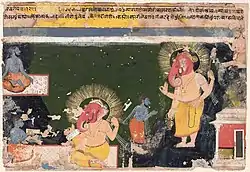
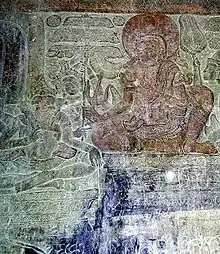
Vyasa is traditionally known as the chronicler of this epic and also features as an important character in Mahābhārata, Vyasa asks Ganesha to assist him in writing the text. Ganesha imposes a precondition that he would do so only if Vyasa would narrate the story without a pause. Vyasa set a counter-condition that Ganesha understands the verses first before transcribing them. Thus Vyasa narrated the entire Mahābhārata and all the Upanishads and the 18 Puranas, while Lord Ganesha wrote.
Vyasa's Jaya (literally, "victory"), the core of the Mahabharata, is a dialogue between Dhritarashtra (the Kuru king and the father of the Kauravas, who opposed the Pāndavas in the Kurukshetra War) and Sanjaya, his adviser and charioteer. Sanjaya narrates the particulars of the Kurukshetra War, fought in eighteen days, chronologically. Dhritarashtra at times asks questions and expresses doubts, sometimes lamenting, fearing the destruction the war would bring on his family, friends and kin.
Large and elaborate lists are given, describing hundreds of kingdoms, tribes, provinces, cities, towns, villages, rivers, mountains, forests, etc. of the (ancient) Indian subcontinent (Bhārata Varsha). Additionally, he gives descriptions of the military formations adopted by each side on each day, the death of individual heroes and the details of the war-races. Eighteen chapters of Vyasa's Jaya constitute the Bhagavad Gita, a sacred text in Hinduism. The Jaya deals with diverse subjects, such as geography, history, warfare, religion and morality.
The final version of Vyasa's work is the Mahābhārata. It is structured as a narration by Ugrasrava Sauti, a professional storyteller, to an assembly of rishis who, in the forest of Naimisha, had just attended the 12-year sacrifice known as Saunaka, also known as Kulapati.
Other texts attributed

Puranas
Vyasa is also credited with the writing of the eighteen major Purāṇas, which are works of Indian literature that cover an encyclopedic range of topics covering various scriptures. His son Shuka narrates the Bhagavata Purana to Arjuna's grandson Parikshit.
Yoga Bhashya
The Yoga Bhashya, a commentary on the Yoga Sutras of Patanjali, is attributed to Vyasa.[18]
Brahma Sutras
The Brahma Sutras are attributed to Badarayana — which makes him the proponent of the crest-jewel school of Hindu philosophy, i.e., Vedanta. Vaishnava Acharyas acknowledge that Badarayana is indeed Vyasa and he is known as Badarayana as he had his ashram in Badari kshetram. Others believe the name to be because the island on which Vyasa was born is said to have been covered with badara (Indian jujube/Ber/Ziziphus mauritiana) trees.[19] Some modern historians, though, suggest that these were two different personalities.
There may have been more than one Vyasa, or the name Vyasa may have been used at times to give credibility to a number of ancient texts.[20] Much ancient Indian literature was a result of long oral tradition with wide cultural significance rather than the result of a single author. However, Vyasa is credited with documenting, compiling, categorizing and writing commentaries on much of this literature.
In Sikhism
In Brahm Avtar, one of the compositions in Dasam Granth, the Second Scripture of Sikhs, Guru Gobind Singh mentions Rishi Vyas as an avatar of Brahma.[21] He is considered the fifth incarnation of Brahma. Guru Gobind Singh wrote a brief account of Rishi Vyas's compositions about great kings— Manu, Prithu, Bharath, Jujat, Ben, Mandata, Dilip, Raghu Raj and Aj[21][22]— and attributed to him the store of Vedic learning.[23]
Legacy
Vyasa is widely revered in Hindu traditions. A grand temple in honour of Sri Veda Vyasa has been built in Orai, Uttar Pradesh. The temple is known as Shri Bal Vyas Mandir. Shrimad Sudhindra Teerth Swamiji, the erstwhile spiritual guru of Sri Kashi Math Samsthan, Varanasi, had the vision to construct this temple in 1998. The temple is managed by the Chitrapur Sarasawath Brahmin (CSB) community who belongs to the said Sri Kashi Math Samsthan. This beautiful temple has now also become a popular tourist destination.
References
- Dalal, Roshen (6 January 2019). The 108 Upanishads: An Introduction. Penguin Random House India Private Limited. ISBN 978-93-5305-377-2.
- Pattanaik, Devdutt (1 September 2000). The Goddess in India: The Five Faces of the Eternal Feminine. Simon and Schuster. ISBN 978-1-59477-537-6.
- Awakening Indians to India. Chinmaya Mission. 2008. p. 167. ISBN 978-81-7597-434-0.
- What Is Hinduism?: Modern Adventures Into a Profound Global Faith. Himalayan Academy Publications. 2007. p. 230. ISBN 978-1-934145-00-5.
- "Rishi Ved Vyas – Trikal Darshi Rajender Bhargav". Retrieved 14 September 2019.
- Essays on the Mahābhārata, Arvind Sharma, Motilal Banarsidass Publisher, p. 205
- Mani, Vettam (1975). Puranic Encyclopaedia: A Comprehensive Dictionary With Special Reference to the Epic and Puranic Literature. Delhi: Motilal Banarsidass. pp. 885 (Vyāsa). ISBN 0-8426-0822-2.
- Sullivan, Bruce M. (1999). Seer of the Fifth Veda: Kr̥ṣṇa Dvaipāyana Vyāsa in the Mahābhārata. Motilal Banarsidass Publ. ISBN 978-81-208-1676-3.
- Skanda Purāṇa, Nāgara Khanda, ch. 147
- Shastri, J. L.; Tagare, Ganesh Vasudeo (1 January 2004). Ancient Indian Tradition and Mythology Volume 7: The Bhagavata-Purana Part 1. Motilal Banarsidass. ISBN 978-81-208-3874-1.
- Strauss, Sarah (2002). "The Master's Narrative: Swami Sivananda and the Transnational Production of Yoga". Journal of Folklore Research. Indiana University Press. 23 (2/3): 221. JSTOR 3814692.
- Monier-Williams, Sir Monier (1875). Indian Wisdom, Or, Examples of the Religious, Philosophical, and Ethical Doctrines of the Hindūs: With a Brief History of the Chief Departments of Sanskṛit Literature, and Some Account of the Past and Present Condition of India, Moral and Intellectual. Wm. H. Allen & Company.
- Bhawalkar, Vanamala (2002). Eminent women in the Mahābhārata. Sharada.
- Kassam, Zayn R. (22 June 2017). Women and Asian Religions. ABC-CLIO. ISBN 978-0-313-08275-7.
- Encyclopaedic Dictionary of Puranas, Volume 1 (2001), page 1408
- "Vishnu Purana". Retrieved 15 March 2014.
- Vishnu Purana -Drauni or Asvathama as Next Vyasa Retrieved 2015-03-22
- Ian Whicher. The Integrity of the Yoga Darsana: A Reconsideration of Classical Yoga. SUNY Press. p. 320.
- Gopal, Madan (1990). K.S. Gautam (ed.). India through the ages. Publication Division, Ministry of Information and Broadcasting, Government of India. p. 74.
- The Yoga Sutras of Patanjali. Edwin F. Bryant 2009 page xl
- Dasam Granth, Dr. SS Kapoor
- Line 8, Brahma Avtar, Dasam Granth
- Line 107, Vyas Avtar, Dasam Granth
Notes
Sources
- The Mahabharata of Krishna-Dwaipayana Vyasa, translated by Kisari Mohan Ganguli, published between 1883 and 1896
- The Arthashastra, translated by Shamasastry, 1915
- The Vishnu-Purana, translated by H. H. Wilson, 1840
- The Bhagavata-Purana, translated by A. C. Bhaktivedanta Swami Prabhupada, 1988 copyright Bhaktivedanta Book Trust
- The Jataka or Stories of the Buddha's Former Births, edited by E. B. Cowell, 1895
External links
 Quotations related to Vyasa at Wikiquote
Quotations related to Vyasa at Wikiquote Media related to Vyasa at Wikimedia Commons
Media related to Vyasa at Wikimedia Commons Works written by or about Vyasa at Wikisource
Works written by or about Vyasa at Wikisource- The Mahābhārata – Ganguli translation, full text at sacred-texts.com
